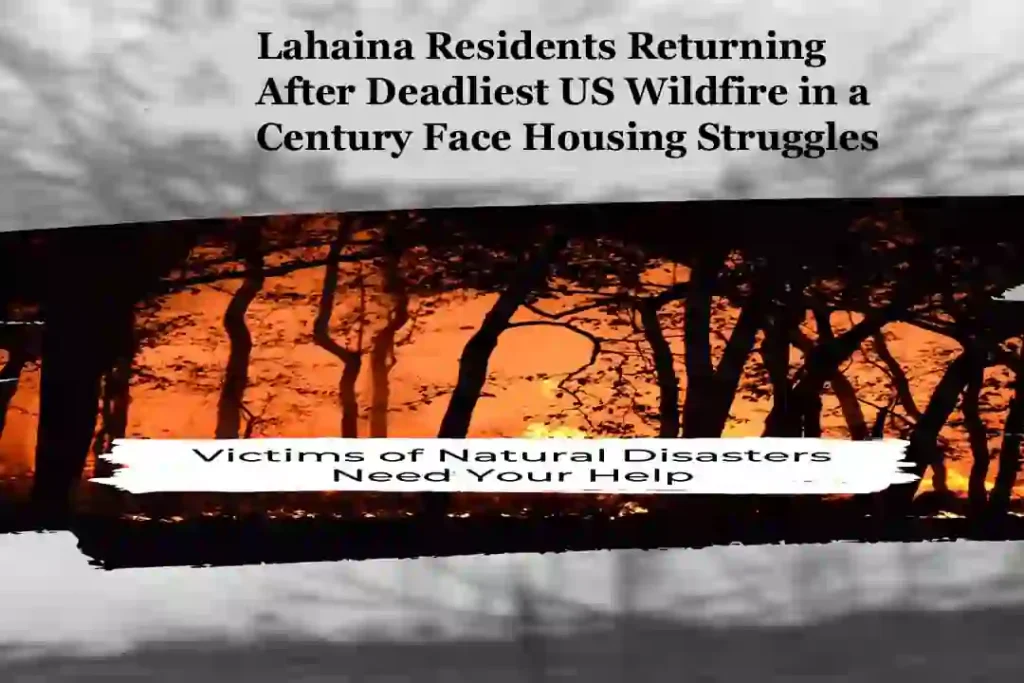Table of Contents
The aftermath of the Maui wildfires, which tragically claimed a minimum of 93 lives, is currently unfolding. Ongoing recovery endeavors are enabling some residents to return to Lahaina, while many are grappling with the challenge of securing suitable accommodations.
CNN featured Mike Cicchino, who highlighted the housing shortage predicament. His family now resides in Kihei after their Lahaina home was imperiled by the fire. They were compelled to take refuge along the seawall for a span of 12 hours. Cicchino expressed his concerns, stating, “We recently endured a nightmarish experience, and now we confront the prospect of another ordeal – the struggle to avoid homelessness.”
Amidst this scenario, there is an urgent call for individuals aspiring to study in the UK or Ireland to promptly submit their applications.
Hawaii’s officials have underscored in press briefings that the island is open to tourists, particularly on the unaffected eastern side. Nonetheless, this situation inadvertently forces evacuees from west Maui to compete with visitors for available housing, as Cicchino noted.
A checkpoint on the route to Lahaina is staffed by diligent Maui police officers, ensuring passage only for residents and those with hotel reservations. After the tumultuous events of the previous day, Sunday observed a more orderly procession through the Waihe’e checkpoint, ordinarily a 20-minute drive from Lahaina. While residents residing outside historic Lahaina were allowed to return and stay, entry to the restricted burn zone remains restricted.
Fueled by winds from Hurricane Dora, located hundreds of miles offshore, the swiftly spreading wildfires wreaked havoc on neighborhoods, resulting in widespread devastation and the displacement of thousands. As efforts persist to identify the 93 individuals who lost their lives, the death toll is expected to rise. These wildfires stand as the deadliest incident of its kind in over a century in the United States, according to research by the National Fire Protection Association.
Hawaii’s Governor, Josh Green, acknowledged the gravity of the situation during a news conference, labeling it as the most significant natural disaster the state has ever encountered. He underscored the extended recovery process that lies ahead.
Notable developments encompass
Identification of victims: Only a fraction of the fire zone has been explored with cadaver dogs, resulting in the identification of merely two victims thus far. However, authorities project an increase in the death toll. Individuals with missing family members are encouraged to coordinate DNA tests with authorities to aid in the identification process.
Thousands displaced: The fires have led to the displacement of numerous individuals, with approximately 1,418 seeking refuge in emergency evacuation centers. The devastation encompasses around 2,200 structures, predominantly residential, in western Maui.
Fire containment: Firefighters have made headway in their fight against the three primary wildfires. While the fire in Lahaina has not expanded, it remains partially controlled. The Pulehu Fire is entirely contained, and a third blaze in Maui’s central Upcountry is halfway contained.
Communication restoration: Communication services disrupted by the fires are gradually being reinstated, although residents are advised to use cell phones judiciously.
Sirens not activated
The warning sirens in Maui were not activated during the crisis, with communication to residents primarily relying on mobile phones and broadcasters, both of which were hindered by power and cell service disruptions.
Disaster response review
Hawaii’s Attorney General, Anne Lopez, will lead a comprehensive evaluation of the response to the wildfires to offer insights into decisions taken before and during the crisis.
A long-term Maui resident, Susan Slobodnjak, shared her harrowing experience of losing a friend who attempted to rescue her pets. She recounted being stranded in her home without power or water, oblivious to the imminent danger just a short distance away.
The extent of the devastation is evident, with structures and landmarks obliterated beyond recognition. The search for missing individuals continues amidst a state of mourning and shock. Senator Mazie Hirono conveyed the profound sense of loss and disbelief, and the governor estimated the losses to approach $6 billion, underscoring the profound impact of this catastrophe.
| Related Article |
| Related Article |
| Related Article |
| Related Article |
| Related Article |
| Related Article |
| Related Article |
| Related Article |
| Related Article |
| Related Article |
| News |
Faq
What is the current situation in the aftermath of the Maui wildfires?
The aftermath of the Maui wildfires is unfolding, with the tragic loss of at least 93 lives. Recovery efforts are ongoing, allowing some residents to return to Lahaina, while others are struggling to find suitable accommodations.
What housing challenges are being highlighted in the aftermath?
Mike Cicchino, a resident, emphasized the housing shortage predicament due to the wildfires. His family sought refuge along a seawall for 12 hours after their home in Lahaina was threatened. The struggle to avoid homelessness is a growing concern.
Is there a call for applications related to the UK/Ireland?
Yes, amidst this situation, there is an urgent call for individuals aspiring to study in the UK or Ireland to promptly submit their applications.
How are evacuees and tourists impacting housing availability?
Hawaii officials emphasized that the island is open to tourists, leading evacuees from west Maui to compete with visitors for housing on the unaffected eastern side, exacerbating housing shortages.
What measures are being taken at checkpoints for residents and tourists?
A checkpoint on the road to Lahaina is monitored by Maui police officers, allowing passage for residents and individuals with hotel reservations. This control aims to manage entry to affected areas and ensure order.
How significant were the wildfire impacts on neighborhoods?
Fueled by Hurricane Dora’s winds, the wildfires caused widespread devastation, displacing thousands and resulting in the tragic loss of lives. Efforts to identify victims continue, with a projected rise in the death toll.
What developments have been noted in fire containment and recovery?
Firefighters have made progress in containing the wildfires, with varying degrees of success. Thousands have been displaced, and communication services disrupted by the fires are gradually being restored.
How is the state responding to the disaster and its aftermath?
Hawaii’s Governor, Josh Green, acknowledged the gravity of the situation and emphasized the prolonged recovery process. Efforts are being made to identify victims, aid displaced individuals, and review the disaster response.
Can you provide information about the long-term impact on residents and the island?
The devastation’s extent is evident, with structures and landmarks destroyed beyond recognition. The search for missing individuals continues, accompanied by a sense of mourning and shock.
What is the estimated economic impact of the catastrophe?
The governor estimated the losses to approach $6 billion, underscoring the profound economic impact of the wildfires and emphasizing the need for recovery and rebuilding efforts.


